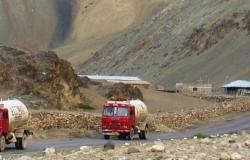The New Silk Road – A Health Diplomacy and Governance Perspective

Ilona Kickbusch and Haik Nikogosian explores the potential role of health diplomacy along the new Silk Road.
The new Silk Road concept and initiatives have captured regional and global attention in recent years.[1][2] The renewed focus on one of the most prominent ancient forms of globalization reflects the aspirations and opportunities for greater connectivity, cooperation and stability in the modern world - in a vast region from China to the Mediterranean and potentially beyond.
The new Silk Road initiatives have so far been discussed mainly in political and economic terms. Health however represents an important dimension, through the way it's embedded in economic development, cross-border determinants and international cooperation. From the viewpoint of health diplomacy and governance, we consider the following aspects to gain particular significance in the unfolding framework of the new Silk Road.
First, the health status of populations and the strength of health systems and regulations vary considerably in countries along the new Silk Road.[3][4] The relevance of such discrepancies will increase as the economic integration, resulting in elevated trade, connectivity and migration, unfolds. Countries will need to increase their collaboration for better synergy in public health capacities, regulations and outcomes to fit the expectations triggered by unfolding economic convergence and the flow of people in the new economic space. This would in turn require more active health diplomacy in the region, both bilaterally and in multi-country settings.
Second, the Silk Road initiatives are already at the forefront and intersections of trade, economic and transport policies in the region. It is also evident that such large infrastructure projects will be watched closely for their environmental impact. Furthermore the overall new Silk Road concept is strongly embedded in foreign, development and investment policies of the participating countries. Health has its own interface with all above sectors and domains, widely recognized by governments and internationally. Such cross-sectoral interface with the key pillars of the new Silk Road underlines the relevance of health as potentially diplomatic vehicle and catalyst for connecting and engaging countries along this road.
Third, it is evident that major public health issues and domains, such as communicable diseases, health security, healthy lifestyles, illegal substances and road safety, would benefit from, or affected by, from the increased flow of people, information, goods and services along the new Silk Road. Opportunities also arise for increased trade in health products, services and technologies, establishing cross-border labs for better health security and founding new healthcare hubs[5] to attract medical tourism. Increased cooperation among the countries in the region will be required to manage such emerging pressures on, and opportunities for, cross-border health and public health in general, and enhanced negotiations and diplomacy for health to fuel and promote such cooperation specifically.
Fourth, there is a substantial role that the key global health instruments addressing major aspects of cross-border and international health can play in supporting the public health dimension of the new Silk Road. This would include the recent legal instruments such as the International Health Regulations (2005)[6] and the WHO Framework Convention on Tobacco Control[7] (including its Protocol on illicit trade[8]) and some of the WHO’s global codes, frameworks, action plans and networks such as those addressing health workforce[9], intellectual property and public health[10], food safety[11] and antimicrobial resistance[12], to name a few. In addition, several regional instruments, such as Health2020[13], the Pan European transport, health and environment programme[14] and the Protocol on Water and Health[15], with their legal, multisectoral and/or overarching policy strength, would facilitate the evolving trans-border cooperation for health. The utilization of widely acknowledged international instruments would without doubt promote cross-fertilization between the health dimension of the new Silk Road initiatives and broader regional and global agenda for heath.
Fifth, the health dimension of the New Silk Road would exploit ongoing initiatives to boost communication and research exchange in the region. One such facility is the UNESCO Silk Road Online Platform[16] aimed at facilitating cultural and scientific dialogue and exchange in the region. Other initiatives include the Trans Eurasia Information Network (TEIN)[17], sometimes referred to as Digital Silk Road, and the Central Asia Research and Education Network (CAREN)[18]. Networks supported by intergovernmental blocks encompassing the new Silk Road, such as research consortia and working groups recently proposed by the BRICS health ministers[19], would contribute to such exchange and dialogue. Sharing of health information and knowledge, including an education strategy for health professionals, science platforms and research collaboration will be an important element for health policy alignment and diplomacy along the new Silk Road.
Finally, as the national and regional mechanism must both support and respond to global governance institutions and processes, the Silk Road initiatives will have the potential to enrich the governance for global health, one of the key governance pillars in the global health domain[20]. Such contribution would be materialized through "club" strategies for health to inevitably emerge as the major infrastructure, trade and transportation projects, with their impact on public health, develop across the new Silk Road. It would also be embedded in multi-sectoral strategies for health of the existing regional organizations whose membership overlaps with the new Silk Road, such as the well-established interface between health and economies in Asia Pacific Economic Cooperation (APEC)[21] and the health and security cooperation interface being underscored by the Shanghai Cooperation Organization (SCO) along with its overall political support to the new Silk Road[22][23].
Conclusions and Outlook
Although not presently in the core of the new Silk Road concept, health however is an important domain to be taken into account while the large trade and economic initiatives in the region take shape. The health dimension of this rapidly evolving economic and geopolitical movement will be manifested in different forms, from the showcase of disparities between the health status of population across the region to the health impact of large infrastructure and transport projects and the utilization of international health instruments to address trans-border dimension of health - all requiring increased dialogue and cooperation to safeguard the interests of public health.
The dynamics envisaged to generate economic growth throughout the Silk Road region through strengthening trade and modernizing infrastructure would benefit considerably if they were matched by the connectivity of investments in health institutions. The linkages between health, foreign policy, investment and trade, and the health agenda of existing political organizations and clubs in the region, linked to regional security and development, will too with no doubt play a catalysing role.
These are the emerging mechanisms and factors to heighten the crucial role of health diplomacy along the new Silk Road. Such diplomacy will be aimed at safeguarding health in the face of evolving trade and economic interests, but it would also serve as an “efficiency instrument” to convene and connect people, sectors and countries due to the crosscutting nature of health. It is therefore natural to expect health diplomacy be closely embedded, ideally from the outset, in the overall diplomacy framework of the new Silk Road.
The health cooperation mechanisms and instruments to emerge in the region have veritable potentials to enrich governance for global health, the new rapidly growing political space in the global health domain. Governments, international organizations, health institutions and experts can utilize the current upsurge of opportunities in health diplomacy and governance to further promote public health and multi-sectoral and multilateral collaboration for health.
Ilona Kickbusch, Haik Nikogosian. Global Health Centre, Graduate Institute for International and Development Studies, Geneva, Switzerland.
Photo credit: Himalayan Trails via Foter.com / CC BY-SA
References
1 Farchy J, Kynge J, Campbell C, et al. The New Trade Routes: Silk Road Corridor. Financial Times 2016 Sep 14. http://ig.ft.com/sites/special-reports/one-belt-one-road/.
2 Li S. The New Silk Road: Assessing Prospects for “Win-Win” Cooperation in Central Asia. Cornell International Affairs Review 2016;9(1).
3 Yan J, Li Y, Gao J, et al. Comparative study of health status between countries along the new Silk Road. Eurasian Journal of Social Sciences 2016;4(2):14-21. doi:10.15604/ejss.2016.04.02.002.
4 Chen L. China-India: reconnecting the Silk Road in health. Lancet 2008;372(9648):1453-54. doi:10.1016/S0140-6736(08)61608-6.
5 Taking the new Silk Road to a better class of healthcare. China Daily Europe 2015 Apr 30. http://europe.chinadaily.com.cn/china/2015-04/30/content_20584222.htm.
6 World Health Organization. International Health Regulations (2005). http://apps.who.int/iris/bitstream/10665/246107/1/9789241580496-eng.pdf?ua=1.
7 World Health Organization. WHO Framework Convention on Tobacco Control. http://apps.who.int/iris/bitstream/10665/42811/1/9241591013.pdf?ua=1.
8 World Health Organization, Protocol to Eliminate Illicit Trade in Tobacco Products. http://apps.who.int/iris/bitstream/10665/80873/1/9789241505246_eng.pdf?ua=1.
9 World Health Organization. WHO Global Code of Practice on the International Recruitment of Health Personnel. http://www.who.int/hrh/migration/code/WHO_global_code_of_practice_EN.pdf.
10 World Health Organization. WHO Global Strategy and Plan of Action on Public Health, Innovation and Intellectual Property. http://www.who.int/phi/publications/Global_Strategy_Plan_Action.pdf.
11 World Health Organization. International Food Safety Authorities Network (INFOSAN). http://www.who.int/foodsafety/areas_work/infosan/en/.
12 World Health Organization. Global Action Plan on Antimicrobial Resistance. http://apps.who.int/iris/bitstream/10665/193736/1/9789241509763_eng.pdf?ua=1.
13 World Health Organization. Health 2020: A European policy framework and strategy for the 21st century. http://www.euro.who.int/__data/assets/pdf_file/0011/199532/Health2020-Long.pdf?ua=1.
14 United Nations Economic Commission for Europe. Transport, Health and Environment Pan-European Programme. http://www.unece.org/thepep/en/welcome.html.
15 World Health Organization. Protocol on Water and Health to the 1992 Convention on the Protection and Use of Transboundary Watercourses and International Lakes. http://www.euro.who.int/__data/assets/pdf_file/0007/88603/E89602.pdf?ua=1.
16 United Nations Educational, Scientific and Cultural Organization. The UNESCO Silk Road Online Platform. https://en.unesco.org/silkroad/unesco-silk-road-online-platform.
17 Trans Eurasia Information Network (TEIN). https://www.aarnet.edu.au/communities/international-community/tein.
18 Central Asia Research and Education Network (CAREN). https://www.caren-noc.org/.
19 BRICS Health ministers meetings: Moscow Declaration. http://www.brics.utoronto.ca/docs/151030-health.pdf.
20 Kickbusch I, Cassar Szabo MM. A new governance space for health. Global Health Action 2014;7:23507.doi:10.3402/gha.v7.23507.
21 Asia-Pacific Economic Cooperation. APEC High Level meeting on Health and the Economy. http://www.apechwg.org/meetings/high-level-meeting.
22 The Shanghai Cooperation Organization. Ufa Declaration the Heads of Member States of the Shanghai Cooperation Organization. http://eng.sectsco.org/load/200119/.
23 The Shanghai Cooperation Organization. The Tashkent Declaration of the Fifteenth Anniversary of the Shanghai Cooperation Organization. http://eng.sectsco.org/load/207886/.


